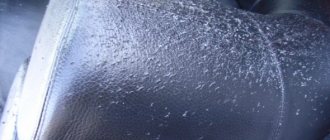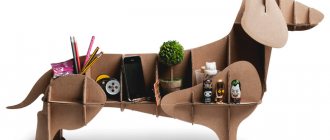Why do cats do this?
A cat does not tear up furniture because it wants to annoy its owners. Even 2-3 thousand years ago, cats were wild animals and, after domestication, retained the hunting skills and instincts necessary for survival in nature. The habit of tearing up furniture for cats has several meanings:
- exercise - during scratching, the muscles of the paws and back tense, as if stretching, and then relax. This “gymnastics” allows animals to constantly be in good shape;
- protection of territory - on the pads of cats' paws there are glands that secrete a sharp-smelling secretion when releasing their claws. Any stranger cat, sniffing the tattered furniture, will understand: there is already an owner in the house, plus he will see the size of the “rival” in terms of the height of the scratches;
- manicure for cats there is no difference between wood and an expensive sideboard. All this is great for sharpening claws. All feline predators have claws that grow throughout their lives and, if they are not ground down, begin to curl into rings, digging into the delicate skin of the paws. Scratching dense, but not too hard objects allows you to keep the claws in the desired shape. In the process, they are cleaned of dirt, dying scales, and become sharper (this is especially important for those cats that were taken into the house as living mousetraps).
You can demand that the cat not tear up the furniture only by offering him an adequate replacement - a comfortable scratching post.
Most often, damaging furniture for a cat is a kind of exercise
A convenient scratching post will help preserve furniture and wallpaper
Stroking the fur
Weaning an animal away from what is its natural behavior is not an easy task. Only prohibitions will not help here. To make it clear to the cat that the owner loves him, and you can sharpen his claws not only on wallpaper, you must not forget to praise your purr. If he picks at the scratching post, pet your pet. This way he will understand much faster which behavior is preferable. Scolding a cat is useless. He may harbor a grudge and further damage things and decor in the apartment in order to take revenge on the owner. If you love your cat, you will definitely find out how to gently stop him from sharpening his claws on interior elements.
Ways to stop an animal from damaging wallpaper and furniture
Before you stop your cat from scratching furniture, you need to understand why the cat does it here. There can be many reasons for this:
- the material of upholstery or wallpaper is most convenient for claws (this is easy to check by covering the “problem area” with a fabric of a different density);
- the height and location of the object allows the cat to stretch comfortably (try rearranging the object and see if the animal continues to scratch it);
- the object turned out to be closest to the place where the animal feels the urge to stretch - for example, after waking up;
- if a cat scratches the furniture on which the owner usually sits, this may be a manifestation of sympathy or a desire to be closer to the person (in this case, it is often enough to install a scratching post closer to your favorite chair or sofa).
Ragged corners can be covered
scratching post
Anti-claw material
There are many ways to stop a cat from scratching furniture. The choice of method depends on the animal’s age, habits, and breed. Maine Coons generally prefer to scratch vertical surfaces and, if you buy them a rug, will continue to scratch their claws on cabinets and sofas. Siamese cats have such a stubborn, vindictive character that at the slightest cruelty on the part of their owners, they will begin to spoil things out of spite.
To prevent your cat from scratching the furniture, offer her an object that is convenient for sharpening her claws, and firmly stop all attempts to encroach on the furniture. Be patient: it sometimes takes up to 2-3 months to develop a positive habit. There are a few simple steps to follow:
- Place the scratching post in the chosen location. For the first day, do not force the cat to approach her. Let her get used to the unfamiliar thing. To make the process go faster, you can hang some clothes on the scratching post that retain the scent of your beloved owner. This way the cat will quickly understand that the new piece of furniture does not pose a threat;
- bring the animal to the nail clipper and, bending your fingers, scratch it with your nails, showing what this item is for;
- Place the cat's paws on the scratching post, apply a little pressure so that the claws protrude from the pads, and force the animal to make several characteristic movements. Be careful: cats do not like coercion, and at the slightest resistance the pet must be released;
- as soon as the animal does what is required of it, caress it and treat it with something tasty;
- every time your pet is about to tear up the furniture, shout sternly at him or lightly spank him on the ears: this is harmless, but very unpleasant;
- Hang your pet’s favorite toy on the cat post so that it dangles freely. Most predators, having gotten caught in an attempt to catch a toy with their claws, begin to sharpen them, after which they quickly realize that doing this here is more convenient than on the armrest of a chair.
There are several tricks to speed up the education process. If the cat ignores the scratching post, you can sprinkle it with catnip or sprinkle it with an infusion of this herb: this smell is pleasant to the animals, which means they will spend more time at their manicure device.
You can discourage your cat from tearing up wallpaper and furniture using water. Prepare a spray bottle and, when the animal settles down to sharpen its claws in the wrong place, spray it in the face. Immediately after this, you need to pick him up, put him on the scratching post and caress him. The conditioned reflex “unpleasant-impossible” and “pleasant-possible” should take hold. For many animals, 3-4 times are enough to remember that you can’t tear up furniture.
If your cat is tearing up the wallpaper, hang a thick wicker rug on the wall in the problem area. Or, if your pet is attracted to the paper covering, make a scratching post for him yourself by gluing several layers of old wallpaper onto cardboard or a sheet of plywood.
It is better to teach a scratching post not when the cat has already begun to damage the furniture, but much earlier, so that later you do not have to think about how to wean the kitten from scratching sofas and wallpaper. The animal must get used to the fact that scratching its claws is only allowed on a scratching post. Kids easily get used to the rules that their owners set for them, but retraining an older kitten is very difficult.
How to protect your interior from cat claws
To prevent a cat from tearing up your favorite sofa or new wallpaper, you need to act with cunning and affection. Scolding and punishing your pet for a damaged interior will not achieve the desired effect. Cats are very freedom-loving and willful; you cannot act “head-on” with them.
Everything needs to be done gradually, for every correct step the cat should be praised and rewarded with treats. A cat will not tear or tear objects if they are protected in a special way:
spray sofas, carpets and wallpaper in the cat’s favorite places with a special product. You can buy such a repeller at a pet store or make your own. The least favorite smells for cats are vinegar, onions and citrus fruits. Vinegar quickly dissipates, onions can be unpleasant for the apartment owners themselves, but a light lemon or orange aroma will only improve the climate in the house. To prepare the solution, add a few drops of lemon juice, orange or tangerine oil to a spray bottle with water. This solution is sprayed on furniture and walls. Place tangerine or orange peels on the floor near objects and corners of interest to the cat - their smell will scare away an animal with a sensitive sense of smell. Cats don't like stickiness, so you can use double-sided tape on the back of a sofa or curtains. You can place tape on the floor near the corner that the cat uses to sharpen its claws. The cat will not scratch the wallpaper if you put something very rustling on the floor, for example, foil.
If humane methods do not help, you can use “heavy artillery”:
- cover the furniture with fabric that is unattractive to the cat;
- cover the corners with plastic or wooden covers;
- keep a spray bottle of water ready, which must be used as soon as the cat approaches a prohibited item;
- build a rattle from a tin can and some stuffing (bolts and nuts, for example) and use it the first time the cat tries to sharpen its claws.
Advice! It is very important that the cat understands why he is being punished. Therefore, it is necessary to use water or a rattle only when he has already begun to tear furniture or walls with his claws
If the animal is not retrained
Some people ignore scratching posts, using exclusively cabinets, cupboards and wallpaper to sharpen their claws. How to stop a cat from scratching furniture and wallpaper in this case:
- come to terms with your pet's habit;
- cover all “problem areas” with thick covers;
- buy several scratching posts and arrange them so that they completely cover the places that he is used to scratching;
- use a special aerosol spray that emits an unpleasant odor for cats. Such preparations as “Api-San”, “Bio Vax”, “Mr. Fresh." As a cheap alternative to a branded spray, lemon juice, onion triple cologne - in short, any other substances that repel cats;
- buy special pads for the paws. They are made of silicone and are dense caps that stick to the claws. They are used both to save expensive furniture from scratches and to protect animal claws. Cats often cling to soft upholstery and injure their paws in an attempt to free themselves;
- and the most barbaric and inhumane method: a surgical operation during which the cat’s claws along with the pads of the fingers will be removed. This will protect furniture and wallpaper with a 100% guarantee. But after this the animal will become disabled and will constantly experience torment.
Anti-scratch
Anti-scratch: closing the claws
Nowadays there are special silicone overlays (caps) for claws on sale. They are glued to the pet over its claws and prevent them from tearing wallpaper and other objects. They fall off on their own, along with the stratum corneum, in about 6-8 weeks. After that you need to stick the following ones. When you first stick them on, cats try to chew them off, but after a day or two they get used to them and don’t pay any attention to them at all.
The use of caps solves two problems - it helps to fall off dead nail formations and wean the cat so that he does not tear up the walls. But not all animals can easily tolerate the procedure of gluing their claws, just as not all owners want to do this. Therefore, we will consider other methods.
How to choose a scratching post and where to place it
Wallpaper and furniture for a cat are an excellent simulator for sharpening claws. They can only be replaced with a properly selected claw sharpener. Moreover, any such item, be it a product specially designed for pet stores or just a piece of board, must meet a number of requirements:
- The height or length of the claw sharpener must exceed the height of the animal with outstretched paws. You can measure this distance by luring the cat with a treat and seeing where it reaches, standing on its hind legs;
- the surface should be hard, but not too hard, rather reminiscent of the texture of tree bark. Hard wood, metal and plastic are not suitable for this purpose. The ideal option is wooden objects covered in several layers of hemp, jute rope or thick sackcloth;
- The outer covering of the scratching post must be made of natural materials, otherwise the pet may be poisoned when licking.
Now there are many options for scratching posts: posts, mats, inclined and horizontal boards. They produce entire complexes where the scratching post is equipped with a sleeping basket and a play area with many toys. You need to choose a scratching post according to the height and weight of the animal. The larger the animal, the higher and more stable the claw sharpening object should be.
It’s easy to make a pet cattery with your own hands. It is enough to wrap an object of suitable length with a rope. Thick natural fabric is well suited as a covering: tarpaulin, burlap, jeans.
Observe the animal and find out how it most often sharpens its claws: standing on its hind legs or arching its back on a horizontal surface? The choice of scratching post will depend on this. Determine where your pet sharpens its claws most often and place a scratching post in that location. If there are a lot of scratched items and they all have different locations, it is better to place several “manicure sets” in several places. There should be at least one thing in every room that a cat can scratch its claws on.
Many cats combine sharpening their claws with stretching. As a rule, they do this after sleep to tone their muscles. In this case, it is better to place the scratching post next to the cat's bed. Then the animal will tear the thing intended for this purpose, and not the expensive carpet.
What should the wallpaper be like in an apartment if there is an “evil cat”
It may also happen that your beloved cat will tear up all the furniture and wallpaper in the house.
So, let's look at the worst case scenario first. Your cat has finally “finished off” the walls, and you need to renovate the room, hallway or kitchen. Or all at once. How to decorate the walls so that the cat can no longer misbehave?
Liquid wallpaper in an apartment is a great way to stop a cat from tearing apart walls.
Options we can focus on:
- liquid wallpaper. If you cover the walls with them, you will thereby deprive the cat of the opportunity to put his claws into them. But then the owner will have to trim the claws.
- Vinyl and fiberglass wallpapers are dense and very durable. Just remember that they must be glued perfectly. Either slightly overlapping, or end-to-end, but so that they do not move away from the wall at all. It is the peeling edges of the wallpaper that are most attractive to a cat. He can grab onto them not only with his claws, but also with his teeth;
- decorative panels - plastic or wooden. They are worth purchasing with a reserve. In extreme cases, if the cat damages one of the panels, it can be replaced with another, quickly restoring the appearance of the wall;
- Porcelain stoneware or tiles are a win-win option. Tile today is produced so elegantly that it is worth purchasing it to decorate many places in the apartment. Moreover, none of your pets can harm him.
We protect repaired walls and wallpaper
But the repairs have been done. The presentable appearance of the home has been restored. The next question on the agenda is how to now protect the apartment from new cat attacks?
As a “folk remedy,” an essential oil with a pungent odor might be suitable. However, there is a significant “but” here, and more than one. Firstly, you will have to process a large area, which will not be cheap. Secondly, if you choose wallpaper, stains from the same oil may appear. It is better to apply this product to the baseboard, or place something aromatic here - lemon peels or other citrus fruits.
Essential oil with a pungent odor repels cats.
You can distract your pet by purchasing several scratching posts for him, or making your own. Fortunately, cats are one of those animals that remember well “this is mine” and happily use their favorite item for its intended purpose. And if you also spray it with a special liquid that attracts a cat, for example with the aroma of valerian or mint, then the scratching post will not be worth the price.
But this is a very dramatic operation, involving a long recovery period during which the animal will experience pain.
It’s simpler and more humane to limit cats’ free access to walls. You can place the furniture so that it is difficult for your pet to get to the wallpaper. Hang carpets or paintings on the walls. As a last resort, nail a piece of carpet or a wooden plank to the place that the cat has chosen.
To prevent the cat from tearing the wallpaper, you need to hang a scratching post on the wall.
You can spray the animal with water from a spray bottle. Finally spank.
But it’s even better if the cat doesn’t get bored. Give him time, give him the opportunity to play active games, for example, running after a bow on a string or another toy. It will be great if the cat has the opportunity to walk. In this case, all natural instincts are realized as intended: the cat will quickly understand that sharpening its claws on the same tree trunk is much more pleasant than damaging furniture and wallpaper at home.
Common mistakes
Considering that animals have individual characters, there is no universal advice for owners. However, there are several methods that should not be used:
- cruelty - beatings will not force the cat to stop scratching furniture, but will make it distrustful and aggressive;
- loud screams - they frighten the animal, thereby interfering with the formation of a conditioned reflex;
- an attempt to wean the cat from scratching furniture without offering the cat an adequate replacement - a scratching post that is convenient for the animal;
- constantly moving the scratching post around the apartment. Once you have placed the item, try not to move it (alternative: purchase an additional scratching post);
- irregularity - when you start accustoming an animal to a scratching post, you need to adhere to a single strategy. If you forbid your pet from scratching the sofa, you will have to shoo him away and take him to the scratching post every time he starts his “manicure,” even if this happens at night. Otherwise, you will not get a positive effect.
Remember that you can punish an animal only if you catch it “at the crime scene”. Even if you spank him a minute after he stops scratching the upholstery, the cat will not understand why he is being spanked. This will not produce an effect, but it will make the furry purr distrustful.
Make sticky surfaces
It is also known that cats do not like sticky surfaces. Therefore, another idea: you can stick double-sided tape on the “wrong place”. There is also adhesive tape that has a transparent base and will not be very noticeable on interior details. Once your pet has become accustomed to this area, the tape can be removed.











